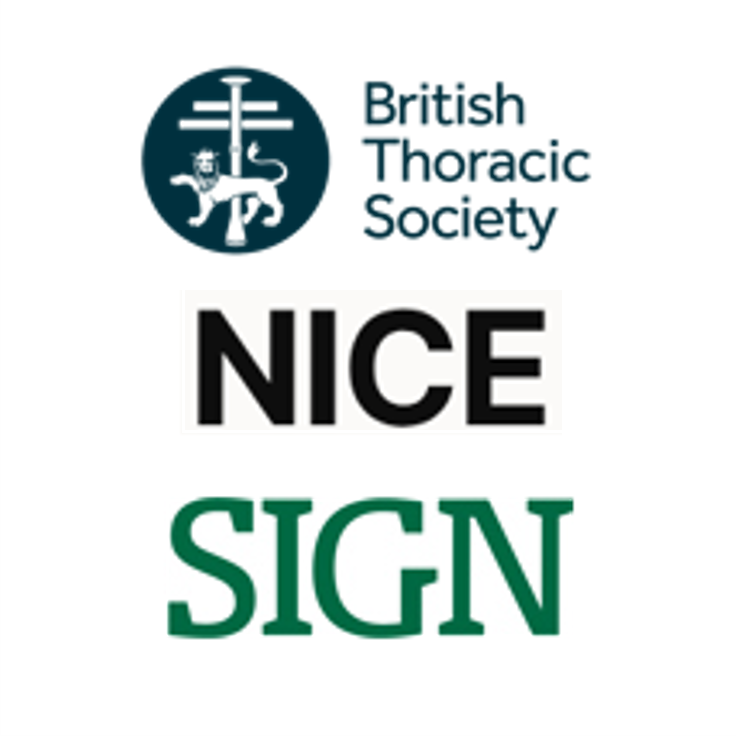Terms used in this guideline

This content is from the BTS, NICE and SIGN guideline - Asthma: diagnosis, monitoring and chronic asthma management, 2024
This section defines terms that have been used in a particular way for this guideline. For other definitions see the NICE glossary and the Think Local, Act Personal Care and Support Jargon Buster.
AIR therapy
Anti-inflammatory reliever (AIR) therapy is treatment with a reliever inhaler that contains a combination of an inhaled corticosteroid and formoterol. When this is used in response to symptoms without regular maintenance therapy it is called as-needed AIR therapy. In November 2024 the only product licensed for as-needed AIR therapy contained budesonide/formoterol.
Asthma control
Complete control of asthma is defined as no daytime symptoms, no night-time awakening due to asthma, no asthma attacks, no need for rescue medication, no limitations on activity including exercise, normal lung function (in practical terms forced expiratory volume in 1 second [FEV1] and/or peak expiratory flow [PEF] more than 80% predicted or best), and minimal side-effects from treatment.
Atopic disorder
Atopic disorders are allergic conditions including allergic rhinitis (hay fever), atopic dermatitis (eczema), allergic asthma and other specific and non-specific allergic conditions such as food allergies.
Bronchial challenge test
A test to measure airway responsiveness (bronchial responsiveness). It is performed by giving small increments of a bronchoconstrictor (most commonly methacholine) and measuring the FEV1 after each dose until it falls by a predetermined amount (usually 20% from baseline).
Bronchial hyperresponsiveness
A measure of how easily bronchospasm can be induced in the airways. It is measured using a bronchial challenge test.
Bronchodilator reversibility
A measure of the ability to reverse obstruction in the airways using medicines that widen the airways (bronchodilators).
Eosinophil count
The number of eosinophils (a type of white blood cell) measured in a blood sample. Their levels are raised in asthma and other allergic diseases, and less commonly with malignant diseases, parasite infections, reactions to some medicines, and a small number of rare diseases.
FeNO test
A test that measures the amount of nitric oxide (NO) present on exhalation, usually expressed in parts per billion.
FEV1
The amount of air that can be forcibly exhaled from the lungs in one second (forced expiratory volume in one second).
Leukotriene receptor antagonist
A type of oral medicine that blocks cysteinyl leukotrienes, used in the treatment of asthma and seasonal allergies. Also known as leukotriene modifiers.
Long-acting beta2 agonist
A long-acting medicine that acts on beta-receptors in the airway to relax airway smooth muscle and relieve symptoms of asthma.
Long-acting muscarinic receptor antagonist
A long-acting medicine that acts on muscarinic receptors in the airway to relax airway smooth muscle and relieve symptoms of asthma.
Maintenance and reliever therapy (MART)
A form of combined ICS plus formoterol treatment in which a single inhaler containing ICS and formoterol is used for daily maintenance therapy and the relief of symptoms as needed. The terms low-dose MART and moderate-dose MART refer to the dosage of the maintenance component of MART. People using MART do not normally need a SABA.
Peak expiratory flow (PEF) variability
PEF is a measure of the maximum speed of expiration, generally expressed in litres per minute. PEF variability is a measure of the extent to which this varies over time and can be expressed numerically as amplitude percentage mean. This is calculated by subtracting the lowest value measured each day from the highest value on the same day, and averaging this over the number of days on which PEF is measured
Skin prick testing
A test that measures the allergic response of an individual to certain specific allergens when a very small amount of the specific allergen is introduced into the skin (usually the inner forearm).
Specialist in asthma care
A healthcare professional with higher training in respiratory medicine and proficiency in the management of asthma. In the context of this guideline, this requires both the relevant expertise and access to the resources that enable delivery of the diagnostic and management pathways described in the recommendations.
Uncontrolled asthma
A term used when asthma is having an impact on a person’s lifestyle, or is restricting their normal activities, because of symptoms such as coughing, wheezing, shortness of breath and chest tightness. Uncontrolled asthma can include one or both of:
- any asthma exacerbation needing treatment with oral corticosteroids
- frequent regular symptoms such as:
- needing a reliever inhaler 3 or more days per week, or
- having 1 or more nights per week when asthma causes night-time waking.
These can be quantified by questionnaires such as the Asthma Control Questionnaire or Asthma Control test.
![]()
![]()
![]()